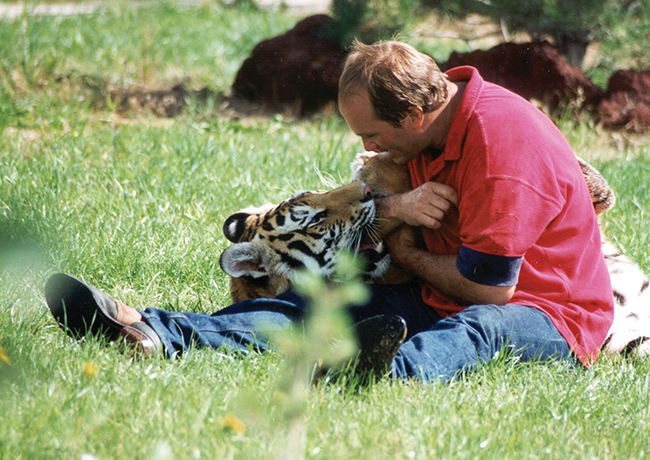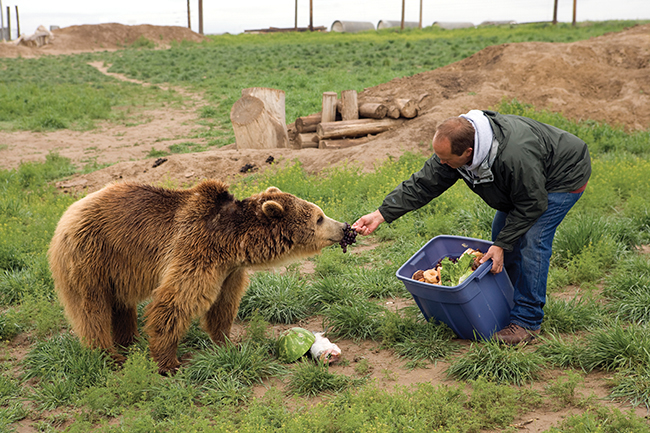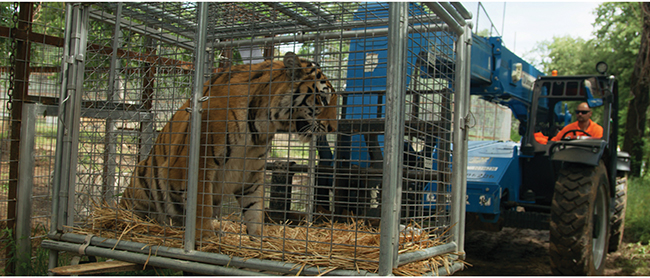From Pickup Truck to Powerhouse
04 Oct 2023
How Pat Craig’s humble beginnings led to the creation of one of the world’s largest and oldest animal sanctuaries
By Grace Adele Boyle

Once the clouds roll in and the temperature drops over the rolling plains of Keenesburg, Colorado, roaring lions and howling wolves can be heard. As the sun begins to set, clinking glasses and conversation mingle with the growls and mix with the smells of hors d’oeuvres in the oldest and largest wild animal sanctuary in the world.
Most people don’t realize that just 40 miles northeast of Denver, sits The Wild Animal Sanctuary (TWAS). It hosts its Summer Safari Dinners to educate, fundraise and include the public in one of the most sought-after experiences in Colorado.
While these special dinners are only hosted four times a year, TWAS is open to the public 361 days a year from 9 am to sunset. The entire 33,000+ acre sanctuary is connected by the world’s longest elevated walkway, giving visitors a bird’s eye view of these majestic creatures roaming freely throughout the sanctuary. TWAS is home to 750+ animals that were rescued from abusive or illegal captivity or had been scheduled for euthanasia at zoos.
“Our goal wasn’t to be the biggest or have the most animals but, for anyone who starts to help animals, at some point, your goal is to help as many as you can, responsibly,” says Pat Craig, founder of TWAS.
Craig’s mission was thrown into the spotlight when Netflix aired Tiger King at the beginning of the pandemic. Politicians and citizens alike were sitting at home anxiously binging the true crime documentary and the emotional reaction hit critical mass.
“Tiger King really brought the reality of exotic animal welfare and abuse into the public eye. Congressmen and senators were being put under immense pressure from the public, so the United States Department of Justice (DOJ) got involved –– and called us,” Craig explains.
The DOJ sent a standard communication to sanctuaries all over the country saying they wanted to do something about the Tiger King situation. Craig told the DOJ that TWAS had done these types of rescues before, and they were happy to help.
“But I warned them,” Craig adds. “All these other sanctuaries you’ve reached out to, they have great people, their hearts are in the right place but most of them don’t even have their own transportation to haul these animals.”
Thinking Craig was being a little overconfident, the DOJ shrugged off his warning and scheduled a conference call with all the sanctuaries that agreed to help.
“The call began and they started with us, asking me to list off everything we could bring,” Craig says. “I explained we have air-conditioned trucks and trailers ready to go, forklifts to move cages, 82 transport crates, 19 staff members, four full-time vets and vet hospitals on call.”
The DOJ said, “OK great,” and then moved to the next sanctuary on the call.
“How many vets do you have?”
“None…”
“Ok, how many trucks and trailers?”
“None…”
“How many forklifts?”
“None, but we can borrow a truck from someone, and I think we can borrow a cage.”
That’s when the reality lightbulb turned on for the DOJ. Most sanctuaries they contacted could take in a tiger or two, but they didn’t have the equipment or manpower needed to transport and give immediate medical care to the animals. So, TWAS coordinated the resources of all the sanctuaries, and together they successfully rescued the tigers.
“It takes a lot of money to have fleets of trucks and trailers –– it’s millions of dollars of equipment,” Craig explains.
For decades, TWAS has prioritized fundraising and building habitats ahead of demand in preparation for unexpected rescues and unforeseen disasters. So, when Puerto Rico was hit by two major hurricanes in 2017 destroying the zoo –– TWAS was ready.
The situation in Puerto Rico was dire and the DOJ had no budget for an animal rescue, so this time they called Craig directly. The zoo had been forced to close to the public earlier that year due to years of financial struggle –– with the animals’ steadily decreasing welfare bearing the weight of that burden. By the time Craig and his team arrived, the entire island had been without power for months and the animals were sick and dying.

One elephant in particular, Mundi, ignited the passions of locals who did not want to see the animals leave the island, regardless of their welfare. Protestors dressed in camouflage began sneaking into the dilapidated zoo at night trying to disrupt the rescue mission by attempting to free Mundi, harass her with BB guns and drones and even poison her –– thankfully with no success. The aggression towards TWAS staff from outraged locals escalated from handwritten signs saying, ‘Go to Hell!’ and throwing trash at their bodies to Craig and his colleagues receiving death threats. That’s when the FBI stepped in to help protect TWAS as the rescue mission continued.
From the tiniest container for a goldfish that had been stranded in a forgotten aquarium to a 19,000-pound crate obtained to securely transport Mundi off the island, TWAS managed to transport every animal that could be rescued from Puerto Rico.
“If we hadn’t been ready, those animals would have had nowhere else to go –– they would be dead or being euthanized because there is no other organization that is capable of doing that large of a rescue mission.”
It’s easy to imagine that TWAS began as a well-funded and highly structured organization, but Craig started TWAS with an old pickup truck when he was just 19 years old.
Craig visited a friend working at a zoo on the East Coast over winter break in college and saw firsthand the poor conditions and degree of euthanasia.
“I would have understood if the animals scheduled to be euthanized were old or sick –– but these were young animals, and the zoo simply didn’t have room for them. It was crazy,” Craig explains.
He returned to Colorado and called the Denver Zoo, hoping they could save these animals from euthanasia. Unexpectedly, they also gave him a behind-the-scenes tour. Craig quickly realized it was common practice for zoos to euthanize their surplus animals because none of them had extra room.
So, Craig did what any 19-year-old would do –– he called the United States Department of Agriculture (USDA) to see what could be done. The USDA told Craig, “The zoos are regulated so they can breed, euthanize –– they can do whatever they want.” Craig asked if there was a Humane Society that could help, and when the USDA said there wasn’t, Craig asked, “What would it take to make one?”

The USDA sent Craig a thick book detailing all the regulations necessary to build animal enclosures to code, and after reading through it he thought to himself, I can do this.
Craig had grown up on a small farm outside Boulder that his mother still owned and with her blessing, he got to work building as many enclosures as he could. When he was done, he sat down at his grandmother’s typewriter and sent a letter to every zoo in the country asking if they had any animals scheduled to be euthanized that he could rescue. Within a month, he’d received over 300 responses. Craig started driving around the country, transporting animals in his old pickup truck until he decided to drop out of college and work full-time to support his animal rescue passion.
Craig has dedicated his life to saving and caring for these animals. Over the past 34 years, TWAS has expanded to include four sanctuaries and refuges in Colorado and Texas. The organization has turned into a significant entity with 85 employees, 160 volunteers and dedicated departments for public relations, marketing, development and accounting in addition to their animal care staff, operations and rescue teams.
“None of these facilities were easy to build but it was the right thing to do for the animals. And if that’s the right thing to do –– you need to commit to the work and sacrifice it takes to make that happen.”
TWAS has made it easy and enjoyable to support its facilities. Its website, wildanimalsanctuary.org, accepts donations in every form from financial contributions and in-kind donations to cryptocurrency and food. You can buy a bronze plaque on the elevated walkway with a personalized message or attend one of the exceptional fundraising events like the 5K/10K walk/runs or the elegant Safari Dinners.












